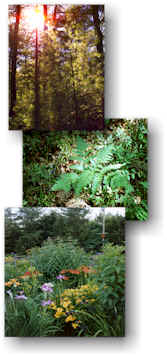Plants

The ecological communities in and around BNL have been classified according to the dominant vegetation and the habitat each provides, using the ecological classification system developed for New York State (Reschke, 1990). Dominant vegetation and associated wildlife as well as the various habitats on and adjacent to BNL were identified during field surveys in December 1993 and again in May, June, August, and October 1994. Ecological communities were classified according to dominant species, density of vegetation, wildlife present, and degree of human disturbance incurred. Particular attention was focused on plants, shrubs, and trees that provided food (nuts, berries, and browse) for area wildlife. The way in which resident wildlife species use the communities was identified (e.g., nesting feeding, roosting, etc.).
The number of plant species on site has been increased by human activities. Lawns, plantings, and plantations on developed portions of the property have increased the number of non-native plants on-site. Due to habitat restrictions, sandy soils, low nutrients, and periodic fires, relatively few non-native plant species have invaded the undisturbed pine barrens habitat. The on-site wetlands generally contain native species, such as common reed (Phragmites australis), which has invaded the large herbaceous wetland on the Peconic River (east of the east firebreak). Common reed appears to be spreading and consequently replacing native wetland vegetation, including cattail (Typha spp.), tussock sedge (Carex stricta), and spiked bur reed (Sparganium eurycarpum).
Twenty-eight plant species identified on-site are protected in New York State under Environmental Conservation Law and New York State Regulation, which states that "no one may knowingly pick, pluck, sever, remove, or carry away (without the consent of the owner thereof) any protected plant". No federally listed threatened or endangered plant species are known to occur at BNL.
| Threatened & Endangered Species, Species of Special Concern, and Species of Greatest Conservation Need | |||
|---|---|---|---|
| Common Name | Scientific Name | State Status | BNL Status |
| Small-flowered false foxglove | Agalinis paupercula | R | Confirmed |
| Stargrass | Aletris farinosa | T | Confirmed |
| Butterfly Weed | Asclepias tuberosa ssp. interior | V | Confirmed |
| Spotted Wintergreen | Chimaphila maculata | V | Confirmed |
| Flowering dogwood | Cornus florida | V | Confirmed |
| Pink lady's slipper | Cypripedium acaule | V | Confirmed |
| Ground pine | Dendrolycopodium obscurum | V | Confirmed |
| Round-leaved sundew | Drosera rotundifolia var. rotundifolia | V | Likely |
| Marginal wood fern | Dryopteris marginalis | V | Confirmed |
| Engleman spikerush | Eleocharis engelmannii | E | Confirmed |
| Eastern showy aster | Eurybia spectabilis | T | Confirmed |
| Dwarf huckleberry | Gaylussacia bigeloviana | E | Confirmed |
| Winterberry | Ilex verticillata | V | Confirmed |
| Sheep laurel | Kalmia angustifolia | V | Confirmed |
| Narrow-leafed bush clover | Lespedeza augustifolia | T | Confirmed |
| Wild lupine | Lupinus perennis | R | Confirmed |
| Whorled loosetrife | Lysimachia quadrifolia | E | Confirmed |
| Bayberry | Myrica pensylvanica | V | Confirmed |
| Stiff-leaved goldenrod | Oligoneuron rigida | T | Possible |
| Cinnamon fern | Osmunda cinnamomea | V | Confirmed |
| Clayton's fern | Osmunda claytoniana | V | Confirmed |
| Royal fern | Osmunda regalis | V | Confirmed |
| Crested fringed orchid | Plantathera cristata | E | Likely |
| Green fringed orchid | Platanthera lacera | V | Confirmed |
| Prostrate knotweed | Polygonum aviculare ssp. buxiforme | E | Possible |
| Bracken fern | Pteridium alquilinum var. | E | Possible |
| Swamp azalea | Rhododendron viscosum | V | Confirmed |
| Long-beaked bald-rush | Rhynchospora scirpoides | R | Confirmed |
| New York fern | Thelypteris novaboracensis | V | Confirmed |
| Marsh fern | Thelypteris palustris var. pubescens | V | Confirmed |
| Possum haw | Viburnum nudum var. nudum | E | Possible |
| Virginia chain-fern | Woodwardia virginica | V | Confirmed |
| Notes: Information based on 6 NYCRR Part 182, 6 NYCRR Part 193, and BNL survey data. | |||
| E = endangered, T = threatened, SC = species of special concern, R = rare, V = exploitably vulnerable, SGCN = species of greatest conservation need | |||
Reference: December 1994; Sitewide Biological Inventory, Phase II. Note: Text citations are found in the above-referenced document.


